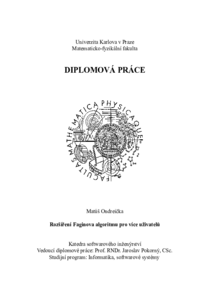Rozšíření Faginova algoritmu pro více uživatelů
Extending Fagin's algorithm for more users.
diplomová práce (OBHÁJENO)

Zobrazit/
Trvalý odkaz
http://hdl.handle.net/20.500.11956/14844Identifikátory
SIS: 46198
Katalog UK: 990014617940106986
Kolekce
- Kvalifikační práce [11363]
Autor
Vedoucí práce
Konzultant práce
Vojtáš, Peter
Oponent práce
Eckhardt, Alan
Fakulta / součást
Matematicko-fyzikální fakulta
Obor
Softwarové systémy
Katedra / ústav / klinika
Katedra softwarového inženýrství
Datum obhajoby
26. 5. 2008
Nakladatel
Univerzita Karlova, Matematicko-fyzikální fakultaJazyk
Čeština
Známka
Výborně
Táto práca sa zaoberá problematikou vyhľadávania K najlepších objektov pre viacerých užívateľov. Každý užívateľ pritom preferuje objekty inak. Užívateľské preferencie sú modelované lokálne pomocou fuzzy funkcií a globálne pomocou agregačnej funkcie. Práca sa zaoberá Faginovými algoritmami, ktoré však vyhľadávajú K najlepších objektov iba vzhľadom na agregačnú funkciu. Kvôli použitiu lokálnych preferencií pri výpočte Faginovho algoritmu vznikla potreba vytvoriť nový model zoznamov, nad ktorými prebieha výpočet Faginovho algoritmu. Nový model zoznamov je založený na B+-stromoch, v ktorých sú indexované objekty nezávisle na preferenciách užívateľov. Práca sa ďalej zaoberá použitím viacrozmerého B-stromu na vyhľadávanie K najlepších objektov podľa užívateľských preferencií vzhľadom ku Faginovým algoritmom. Práca prináša nové riešenie založené na viacrozmernom B-strome, VB-algoritmus.V závere práce sú uvedené výsledky testov všetkých popisovaných algoritmov.
We discuss the issue of searching the best K objects in more attributes for more users. Every user prefers objects in different ways. User preferences are modelled locally with a fuzzy function and globally with an aggregation function. Also, we discuss the issue of searching the best K objects without accessing all objects. We deal with the use of local preferences when computing Fagin's algorithms. We created a new model of lists for Fagin's algorithms based on B+-trees. Furthermore, we deal with the use of a multidimensional B-tree for searching the best K objects. We developed an MD-algorithm, which can effectively find the best K objects in a multidimensional B-tree in accordance with user's preferences and without accessing all the objects. Last but not least, we show results of all the tests of described algorithms. MD-algorithm achieves better results in the number of accessed objects than Fagin's algorithms.
